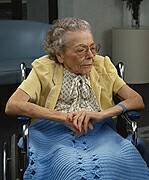- Tips for Spending Holiday Time With Family Members Who Live with Dementia
- Tainted Cucumbers Now Linked to 100 Salmonella Cases in 23 States
- Check Your Pantry, Lay’s Classic Potato Chips Recalled Due to Milk Allergy Risk
- Norovirus Sickens Hundreds on Three Cruise Ships: CDC
- Not Just Blabber: What Baby’s First Vocalizations and Coos Can Tell Us
- What’s the Link Between Memory Problems and Sexism?
- Supreme Court to Decide on South Carolina’s Bid to Cut Funding for Planned Parenthood
- Antibiotics Do Not Increase Risks for Cognitive Decline, Dementia in Older Adults, New Data Says
- A New Way to Treat Sjögren’s Disease? Researchers Are Hopeful
- Some Abortion Pill Users Surprised By Pain, Study Says
Leg Artery Procedure May Be Overused in Nursing Homes, Study Finds


Surgery to reopen blocked arteries in the legs of frail nursing home residents rarely gets them back on their feet, a new study shows.
In fact, many elderly people who undergo the expensive procedure either lose more physical function or die within a year of the surgery, according to a review of Medicare claims data by researchers from the University of California, San Francisco (UCSF).
However, that doesn’t prove the surgery is unnecessary in all or even many cases, said senior study author Dr. Emily Finlayson, director of the UCSF Center for Surgery in Older Adults.
Blocked blood vessels in a leg can cause extreme and chronic pain, or promote infections or gangrene that can lead to amputation. “This operation can actually make those symptoms better,” Finlayson explained. “Even if that patient only has six to eight months to live, this may be an appropriate operation to ease suffering for those patients.”
The study, published April 6 in the journal JAMA Internal Medicine, focused on a procedure called lower extremity revascularization in which doctors restore blood flow to the leg by performing bypass surgery or inserting a stent into the narrowed artery.
Patients who need this procedure suffer from peripheral artery disease, in which the blood vessels to the leg or hip muscles become narrowed or blocked due to plaque buildup in the arteries. The painful condition can sometimes lead to amputation.
Peripheral artery disease is common among nursing home residents with little or no mobility, and doctors often opt for lower extremity revascularization to treat it, the authors said in background information.
Medicare claims data revealed that almost 11,000 long-term nursing home residents had undergone the procedure between 2005 and 2009.
Their average age was 82, and many were in very poor health. Three out of four could not walk, and 40 percent had experienced a decline in their overall physical function. In addition, 60 percent had mental impairment, 57 percent had congestive heart failure and 29 percent had kidney failure.
The common goal of the procedure among younger patients is to restore function in the leg and get the person walking again, Finlayson said. By that standard, it rarely succeeds in this group of patients.
A year after surgery, half of the patients had died. Among nearly 7,200 patients unable to walk prior to surgery, 89 percent either died or remained off their feet.
Even those who could walk before the procedure suffered in its aftermath. Of 1,672 nursing home residents who could walk beforehand, 63 percent had died or lost the ability to walk within a year.
These outcomes are understandable, given how hard any form of surgery is on people this old and frail, Finlayson said.
“Many patients do not ever get back to their baseline function, regardless of what kind of procedure they have,” Finlayson said.
The cost varies across the nation, but these patients tend to have high complication rates that drive up the total cost of care, Finlayson added.
However, Finlayson said her findings should not be used to declare the surgery wasteful and useless.
She likened the procedure to repairing a broken hip. “We know if it’s not fixed, it causes excruciating pain and increasing disability. The goals of surgery are sometimes to prolong life, but sometimes they’re to ease symptoms and ease suffering,” she explained.
Dr. William Hall, director of the Center for Healthy Aging at Highland Hospital at the University of Rochester Medical Center in New York, agreed.
“It could be looked at as a type of palliation, improving the immediate quality of life of these people,” said Hall, who wrote an editorial accompanying the study.
Families of nursing home patients should ask questions about the procedure and make sure it’s the right thing to do, Finlayson and Hall said.
More information
Visit the U.S. National Institutes of Health for more on peripheral artery disease.
Source: HealthDay
Copyright © 2024 HealthDay. All rights reserved.










